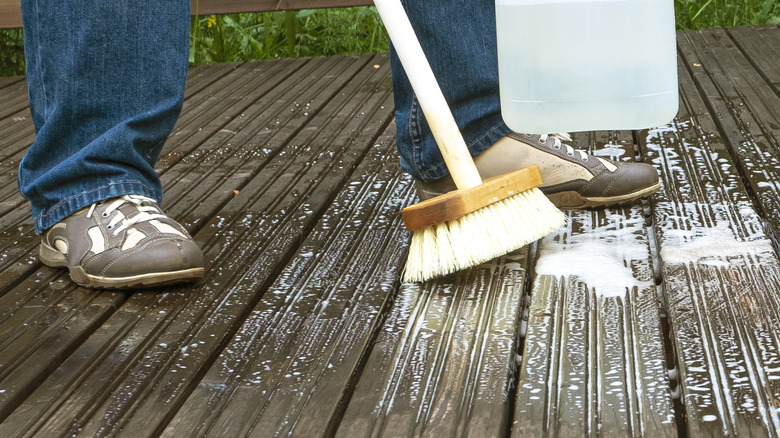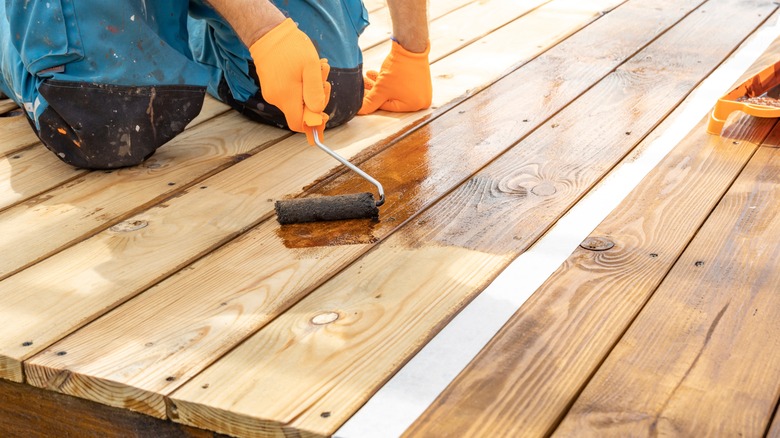The Number One Thing To Do To Protect Your Wood Deck In The Winter
We may receive a commission on purchases made from links.
If you live in a cold weather climate, each year before winter strikes, you probably think that you won't be enjoying your wooden deck for many, many months. You might also think that your work out there is done. Time to put your feet up and enjoy some hot apple cider. However, not so fast! That deck needs your attention, probably in the fall more than at any other time of the year. The number one thing to do to protect your wood deck from damage during the winter is to seal it.
The sealant process begins with preparing your deck with a good cleaning so that the sealant can get into the wood. Once it's on there, the product will check off all the boxes on your list of worries about your deck. It will keep the wood from cracking or warping by protecting it from the moisture from melting snow. The sealant will also protect against the growth of mold and mildew, again because it keeps wetness away from the wood. Adding a sealant is one of the easy ways to protect your deck from fading in the sun, and those UV-blocking qualities also keep the sun's rays from damaging your deck. Now that you know why sealing your wood deck is the number one thing you should do to protect it before winter hits, read on to find out what products to use and how best to do it.
Getting your deck ready to be sealed
Before you get started, make sure your deck is clean and ready for the sealant. Take everything off the deck (you'll probably be putting most of it away for the winter anyway). Next, make life easier with the deck cleaning tricks you should be using yourself. Use a leaf blower or good stiff broom to get rid of any loose dirt, leaves, small sticks, dead bugs, and other debris. Once everything is cleared away, wash it, remembering to use special cleaners if necessary to rid your deck of mold, mildew, or embedded grime. It might seem time-consuming especially with shorter days as winter approaches to have to take this extra step, but if the deck isn't clean, the sealant will just attach that grunge right onto the wood.
You could either use a commercial preparation made for decks or a natural cleaner such as vinegar or baking soda (however, using them together may make them ineffective). If some of that deck dirt is actually a bit slimy and green, you might need to keep your wood deck or patio grime-free with a household staple because it is likely to be algae. To tackle this kind of green goo, use hydrogen peroxide, a stiff brush like the Weiler Heavy Duty Deck Scrub Brush, and your own muscle. Don't forget about safety precautions: It's always a good idea to wear eye goggles, gloves, and long sleeves to protect yourself from cleaning products and debris. Once clean, rinse off the deck and allow it to dry.
Sealing your wood deck to protect it all winter
Your clean, dry deck is now ready to be protected by a sealant that will keep it safe during winter. If you got a very early start to the day and it's sunny and dry (always seal on a day like that), you might be lucky and finish in a day. However, you'll probably want to allow for a couple days just to be sure, especially since the deck also might need to be sanded. It's possible that only a few spots will need it, but you also might find yourself lightly sanding the entire deck to give the sealant a good surface to adhere to. If so, sweep it off when you're done.
Choose the deck sealant that is right for your situation. There are two main types of sealants: topical ones or penetrating types. Choose a penetrating type for more protection. You can also either choose a transparent option or one with color to add an aesthetic appeal to your deck. There are many different sealants, though professionals will often recommend using Cabot or Defy brands, which come in innumerable colors and configurations. Be sure to stir the can thoroughly after opening it to mix the contents, then stir it throughout the day if your application takes a while. Avoid shaking the sealant so that bubbles don't form. Thin coats are preferred, but it's your choice whether you apply them with a paint roller, a brush, or a sprayer. You may need more than one coat, but once it's dry, your deck will be winter-ready!


